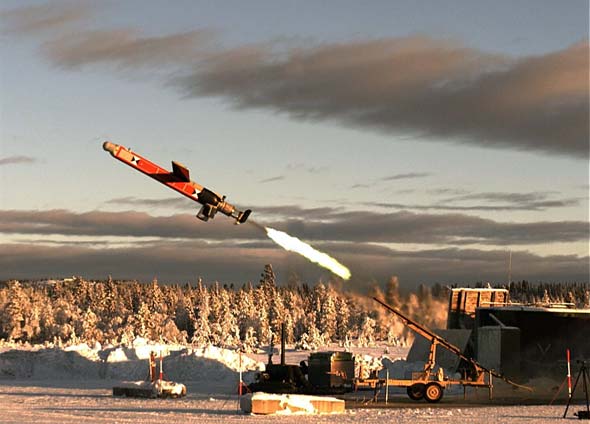
The Fire Shadow loitering weapon system is maturing toward a planned initial deployment in Afghanistan with the British Army next year. MBDA has performed several successful tests recently, the latest system-wide trial was conducted in Sweden in May 2011. According to MBDA, the demonstration trials and firings tests pave the way for a planned entry into service next year with the British Army. The Army plans to deploy the new weapon in Afghanistan, significantly extending the reach, coverage and persistent of current artillery fires.

The first of these firing tests, using a complete weapon system, was carried out on 21st November 2010 at Vidsel, Sweden to demonstrate system integration, launch, stable flight, waypoint navigation and data-link function which supports the maturation of the munition and its control. The munition flew for several tens of kilometres and its trajectory included a number of manoeuvres, such as a loitering pattern. A second test followed a year later, on May 13th 2011 at the same location, employing a more complex trial scenario, exercising the ‘Man-In-The-Loop’ functionality. Throughout the flight the operator was able to select and successfully engage a representative target.
![Fire-Shadow-Firing-May-2011-Copyright-Vidsel-Test-Range-RFN[1]](https://defense-update.com/wp-content/uploads/2011/09/Fire-Shadow-Firing-May-2011-Copyright-Vidsel-Test-Range-RFN1.jpg)
British Army personnel also had a chance to experience the new weapon “hands-on” at the MBDA integration lab at Filton and Bedford, tailored to provide the “look and feel” of the system. The lab enables the military to refine Tactics, Techniques and Procedures (TTPs) and prepare for formal training later in 2010. The system was also demonstrated to operate seamlessly within a modern battlespace HQ context at the Coalition Warrior Interoperability Demonstration event.
Loitering weapons captured the imagination of the UK MOD in the 1990 after an operational analys examining artillery fires capabilities concluded that the artillery required greater precision at range. Better responsiveness and persistent capability to attack individual and groups of manoeuvring and mobile land targets in cluttered environment was required, as an element of the future Indirect Fire Precision Attack (IFPA) programme. Following many iterations, the analysis recommended the loitering munition capability as a key element of any IFPA mix of weapon systems. After more than a decade, this revolutionary concept has matured into the Fire Shadow weapon system, a concept offering the land component an organic, flexible fires effects capable of timely, precisely and persistently support at appropriate ranges, allowing simultaneous attack in deep, close and rear operations throughout the spectrum of conflict.
Fire Shadow provides a precision capability to engage high value targets in complex scenarios. Surface launched, the munitions have a range of about 100 km and can conduct a direct transit to target or be positioned to loiter in the airspace for a significant time (about 6 hours). A Man-In-The-Loop decision then enables a precise and rapid attack against a selected target.
Fire Shadow can be targeted by a range of ISTAR (Intelligence, Surveillance, Target Acquisition and Reconnaissance) systems, for example a forward observer with binoculars or a sophisticated system such as a UAV. If required, the Fire Shadow could loiter in the target area for about 6 hours and will be particularly effective in complex environments such as urban areas. After launch, Fire Shadow may receive real-time target information from a range of sources in a potentially networked environment.

















